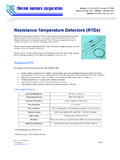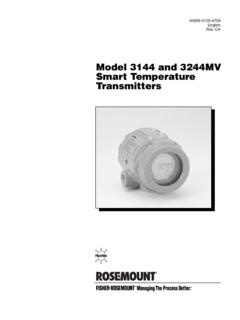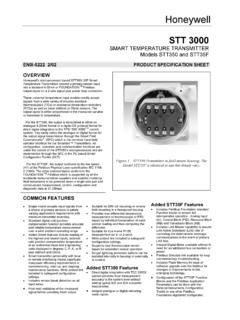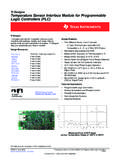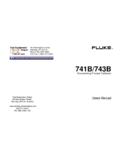Transcription of Thermocouples - Temperature Sensors | Applied …
1 Applied Sensor Technologies offers four basic types of Temperature sensor: Thermocouples rtd s Thermistors Integrated circuit (IC) Thermocouples At its most basic, a thermocouple is two wires of dissimilar metals, joined at one end. Changes in the Temperature at the hot junction (measuring end) induce a change in electromotive force (emf) at the cold junction , where it can be input into a controller or indicator. As the Temperature increases, this output emf also rises, though not completely linearly. Thermocouples can measure temperatures over wide ranges, fairly inexpensively. They are very rugged, but they are somewhat less accurate vs.
2 RTDs and thermistors. Here is a summary of some of the advantages and disadvantages of Thermocouples : Advantages Disadvantages Self powered Non linear Simple Low voltage Rugged Reference required Inexpensive Least stable Wide variety Least sensitive output vs. Temperature change Wide Temperature range thermocouple Types ( Calibrations ) There are many different types of Thermocouples , made of different types of wire and having very different properties. This sometimes makes one type better for a specific application than another. Below are descriptions of the types of Thermocouples that Applied Sensor Technologies manufactures: Type J The most widely used thermocouple ; it is versatile and has widespread usage throughout industry.
3 It is recommended for reducing atmospheres. The operating range for this alloy combination is from 0 to 750 C (32 to 1380 F) for the largest wire sizes. Smaller size wire should operate in correspondingly lower temperatures . Type K Often used at high temperatures , it is recommended for use in clean oxidizing atmospheres. The operating range for this alloy is from 0 to 1250 C (32 to 2280 F) for the largest wire sizes. Smaller size wire should operate in correspondingly lower temperatures . Type E With the highest emf of all standard Thermocouples , it is recommended for use in oxidizing, inert or dry reducing atmospheres or for short periods of time in a vacuum.
4 These elements must be protected from sulfurous and marginally oxidizing atmospheres. Type E Thermocouples can be used for temperatures from 0 to 900 C (32 to 1650 F). thermocouple Types ( Calibrations ), Continued Type T Type T is recommended for use in mildly oxidizing and reducing atmospheres at temperatures from 0 to 350 C (32 to 660 F). It is suitable for applications where moisture is present. This alloy is recommended for low Temperature work since the homogeneity of the component wires can be maintained better than with other base metal wires. Therefore, errors due to material variation within wires in zones of Temperature gradients are greatly reduced.
5 Types R, S & B Made from platinum and platinum alloy wires, these Thermocouples are designed for high Temperature applications, such as vacuum furnaces and a variety of process applications. Because of the chance for contamination, they should be protected by a suitable protection tube, preferably of high-purity alumina (99% or better). Mullite is not recommended for use with Types R&S due to the chance of silica contamination, and the thermocouple should never be inserted directly into a metal thermocouple Constructions Applied Sensor Technologies offers three thermocouple constructions depending on the application: GP - General Purpose Thermocouples that are comprised of a pair of thermocouple wires inside a metal tube.
6 This inexpensive method can typically be used to measure temperatures of 260 C (500 F) or less. MI - For higher Temperature applications, magnesium oxide powder is compacted around the wires inside the sheath. This Mineral Insulated construction is very rugged, can be bent and is used to measure temperatures of throughout the thermocouple s Temperature range (depending on sheath material). BTC - Beaded Thermocouples are constructed of bare wire, separated by ceramic beads. This simple yet effective construction is used for high Temperature applications such as furnaces and many applications in the metals industry.
7 thermocouple Ranges and Accuracy thermocouple conductors are specified with either standard or special limits of error. The chart below shows the usable range of each sensor calibration, along with their accuracies. Accuracy is based on the larger of the two values given, for temperatures above Calibration Insulation color-code (North America) Range Accuracy (Standard Limits) (Special Limits) J White (+) Red (-) 32 to 1380F 0 to 750C or or K Yellow (+) Red (-) -325 to 2280F -200 to 1250C or or E Purple (+) Red (-) -325 to 1650F -200 to 900C or or T Blue (+) Red (-) -420 to 660F -250 to 350C or or R & S Black (+) Red (-) 32 to 2730F 0 to 1500C or or B Gray (+) Red (-)
8 32 to 3100F 0 to 1700C over 800C N/A RTD's or resistance Temperature detectors An RTD capitalizes on the fact that the electrical resistance of a material changes as its Temperature changes. Most rtd s use a thin film of a conductor (platinum, nickel iron or copper) deposited on a ceramic substrate. However, some special applications require the older method of wrapping a length of thin conductor around an insulator. RTD's are stable and have a fairly wide Temperature range, and in many cases are similarly priced to Thermocouples . Because they must be isolated from the environment, they are less responsive to changes compared to grounded or exposed junction Thermocouples .
9 Since they require an electric current source to make measurements, RTD's can be subject to small inaccuracies from self-heating. RTD's can be used to measure temperatures from -200 to 800 C (-325 to 1475 F) Here is a summary of some of the advantages and disadvantages of RTDs: Advantages Disadvantages Stable More expensive than a thermocouple Accurate Current source required More linear than thermocouple Small change in resistance Low absolute resistance Self heating Less rugged that Thermocouples RTD Types The most common type of RTD (and Applied Sensor Technologies standard) is platinum, with characteristics that have been standardized under the European IEC 751 standard.
10 It has a Temperature coefficient ( ) of and its reference resistance is 100 . There are also variations of the platinum that have 500 and 1000 references, and a similar RTD with an = (called the American curve, it has different levels of purity to the platinum and is much less common). In addition, there are rtd s made from copper and nickel-iron. Applied Sensor Technologies can offer any of these as options if required. RTD Wiring Configurations Because the absolute resistance of the RTD element is relatively small in most cases (roughly 100 ), the leadwire length between the sensor and the measuring equipment becomes a potential area of significant error.


